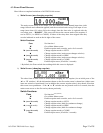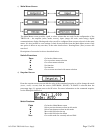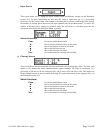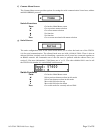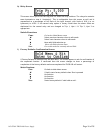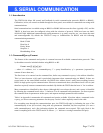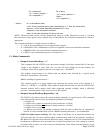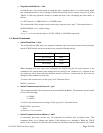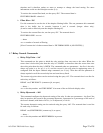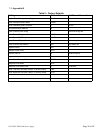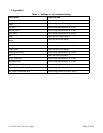
165-072011 THCD-100 Power Supply Page 20 of 28
g. Setpoint Initial Mode – ‘sim’
As with the value, the setpoint mode set using the ‘spm’ command (above) is a volatile setting. Again
this command provides a way of setting an initial startup mode for the setpoint on power up of the
THCD. It takes one parameter which is a number between 0 & 2, identifying the initial mode, as
follows:
0 = AUTO mode 1 = OPEN mode 2 = CLOSED mode
The current mode of the setpoint can be retrieved by using the query ‘spm?’. The returned data is:
SP INIT MODE: (<x>) <mode string>
… where …
<x> = 0, 1, or 2 and <mode string> = AUTO, OPEN, or CLOSED respectively.
5.4. Serial Commands
a) Serial Baud Rate – ‘bra’
The serial baud rate (BR) can be set using this command. Any value can be entered as the parameter
and the THCD decides on the actual baud rate using the following criteria:
When changing baud rate using serial commands, the THCD will give the usual response to the
command at the current baud, then change baud rate and give the !<address>!o!↵ response at the
new baud rate. Host front ends can therefore monitor for this to confirm that the baud rate has
changed. If this command is used with
To retrieve the current baud, use the query ‘bra?’. Returned data is:
BAUD: <baud rate>
b)
Serial Communication Protocol – ‘pro’
This command switches the serial protocols between RS232 & RS485. The parameter passed should
be one of the following:
0 = RS485
1 = RS232
To retrieve the current protocol setting, use the query ‘pro?’. Returned data is:
PROTOCOL: <protocol>
… where
<protocol> = 0 or 1 as above.
c)
Serial Communication Address – ‘add’
As mentioned previously (section 4.2), all commands are prefixed with an address letter. This
command allows you to change that address. Valid addresses are a through h. When the THCD
replies to the command, the first line will contain the old address and the response line will contain
Parameter value (BR) Actual baud rate
BR < 14400
9600
14400 ≤ BR < 28800
19200
BR ≥ 28800
57600



